The US President's Malaria Initiative, transmission and mortality: A modelling study
Peter Winskill and colleagues estimate the influence the US President's Malaria Initiative funding has had on averting malaria-related cases and deaths over the past decade and the potential impact if PMI funding is reduced going forward.
Published in the journal:
. PLoS Med 14(11): e32767. doi:10.1371/journal.pmed.1002448
Category:
Research Article
doi:
https://doi.org/10.1371/journal.pmed.1002448
Summary
Peter Winskill and colleagues estimate the influence the US President's Malaria Initiative funding has had on averting malaria-related cases and deaths over the past decade and the potential impact if PMI funding is reduced going forward.
Introduction
Unprecedented effort has seen the global burden of malaria halve since the turn of the 21st century due to the widespread distribution of highly effective preventative interventions such as long-lasting insecticide treated nets (LLINs) and indoor residual spraying (IRS) and the provision of highly efficacious treatment with artemisinin combination therapies (ACTs) [1]. However, funding for malaria control has plateaued, falling well behind what is necessary to expand protection to all those in need [2,3]. The continued high level of support for foreign aid contributions in a fluid global political landscape is not guaranteed and gains in malaria control can be fragile if intervention coverage, which is largely dependent on donor funding, is not maintained [4].
The US is the world’s largest donor of foreign aid for malaria control [5] and therefore a mainstay in global malaria efforts. The President’s Malaria Initiative (PMI), established in 2005 and funded by the United States Agency for International Development (USAID), has been particularly influential in investing in malaria control over the past 12 years [6]. PMI provides support to malaria control programmes in 19 African focus countries and the Greater Mekong Subregion (GMS) and is the largest bilateral funder of malaria prevention and treatment [5,7]. In the 12 years since its inception, PMI has procured 197 million LLINs and 378 million courses of ACTs, provided over 215 million person-years of protection with IRS, and distributed 35.7 million courses of preventative therapy for pregnant women [6]. In 2015, PMI funding represented over one-fifth of the global malaria budget envelope [5,6]. In a recent statistical analysis, the influence of PMI funding has been estimated to have had significant impact on under-5 mortality in sub-Saharan Africa, with an estimated reduction of 16% [8]. The US’s commitment to overseas aid has been threatened in recent months [9], highlighting the fragility of global funding for malaria control and a reliance on global political stability. In May 2017, Congress published the Congressional Budget Justification [9], which outlined a commitment to malaria control for 2018 of US$424 million. This is equivalent to a 44% reduction relative to commitments reported for 2017 [10].
To quantify the importance of the PMI contribution to global malaria efforts, we combined data on PMI commodity contributions over time and by country [6] with a mathematical model of the impact of interventions on malaria transmission, morbidity, and mortality parameterised at the subnational level [11] and previously used to inform the Global Technical Strategy (GTS) for malaria [5]. We used this to estimate the global health impact of past PMI funding and the potential implications that a reduction in funding from a key stakeholder and donor in the near term could have on malaria globally.
Methods
We linked data on PMI financing, historical intervention coverage, and the underlying epidemiology in modelled countries with estimates of the potential effect of reduction in PMI funding on the coverage of interventions nationally. These estimates were then used as inputs for an established transmission model of P. falciparum malaria [11,12] to project the impact of reductions in funding on cases, deaths, and Disability Adjusted Life Years (DALYs) (Fig 1).
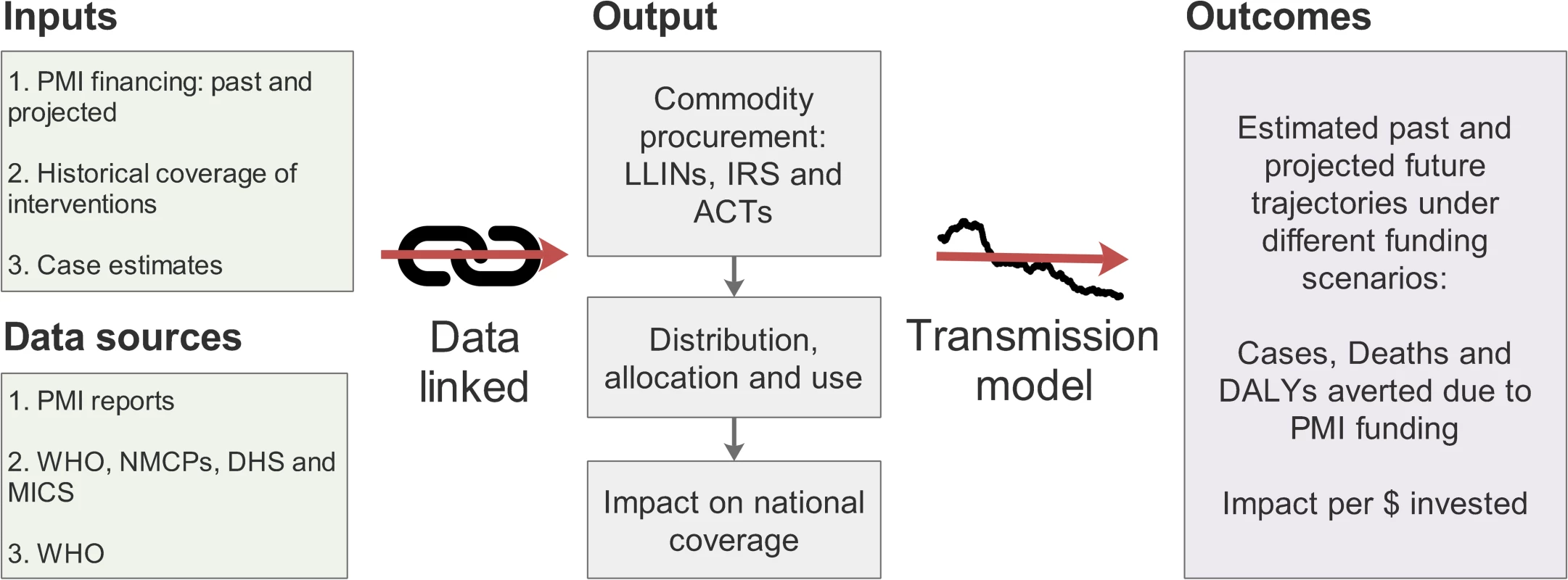
Mathematical model
We used an established individual-based malaria transmission model that incorporates a full dynamic mosquito-vector element to allow vector-control interventions to be accurately represented [13]. We briefly describe the model structure below. Full mathematical details can be found in S1 Appendix, Text A-I, and associated references [11,12].
Modelled humans are initially susceptible and may become infected, with a given probability, via the bite of an infectious mosquito. Upon infection, following a period reflecting liver-stage infection, an individual may become symptomatic and seek treatment. Successfully treated individuals benefit from a period of drug-dependent prophylaxis before returning to the susceptible compartment. Symptomatic individuals who do not receive treatment experience a period of symptomatic disease (which has high onward infectivity) before recovering to an asymptomatic state. These individuals, along with those who experience asymptomatic infection, move from being patently asymptomatic to subpatent before natural clearance moves them back into the susceptible compartment. Superinfection can occur from all asymptomatic and subpatent states. Those who experience clinical disease are considered at risk from severe disease and its associated mortality [14].
Naturally acquired immunity is incorporated at several stages of the infection process [12]. Clinical immunity is developed earliest, protecting individuals against severe disease and then clinical disease, and is exposure driven with an age-dependent component to the severe disease pathology and associated mortality rate. Antiparasite immunity develops later, driven by both age and exposure to infection, and reduces the detectability of infections through the control of parasite density. A degree of anti-infection immunity develops later in life, reducing the probability that an infectious bite results in patent infection. The parameters determining the acquisition of immunity were estimated through fitting to severe disease incidence, clinical incidence, and parasite prevalence data stratified by age across a range of transmission settings [12,15].
All infection states are assumed to be onwardly infectious to mosquitoes, with infectivity correlated with parasite density (i.e., highest for clinical disease, intermediate for patent asymptomatic infection, and lowest for subpatent infection), with the parameters estimated by fitting to mosquito feeding studies [12,14,15].
Vectors are modelled as a stochastic compartmental formulation incorporating the larval stages of infection and adult female infection stages [10, 13].
Geographically specific data inputs
We modelled each first administrative unit (first administrative level below national) in all countries with stable malaria transmission, totalling 1,020 administrative units. Prior scale-up of interventions (LLINs and IRS) was estimated from World Malaria Report data [16], which are based on reports from National Malaria Control Programmes (NMCPs). Demographic and Health Survey (DHS) and Multiple Indicator Cluster Surveys (MICS) for within Africa [17] and World Malaria Report [18] estimates for elsewhere were used to estimate treatment coverage. It was assumed there was no prior scale-up of seasonal malaria chemoprevention (SMC). Each administrative unit was assigned a seasonal pattern that determined the seasonal fluctuation in the carrying capacity of the environment. Seasonality was estimated using Fourier transformations of daily rainfall data from 2002–2009 from Garske et al. (2013) [19]. The carrying capacity was then fitted to 2015 estimates of prevalence (within Africa) [1] or cases (outside of Africa) [16,20] using a root-finding algorithm. Data on populations were compiled from the Gridded Population of the World dataset, adjusted for United Nations estimates of country-level populations [21]. Estimates of the spatial limits of P. falciparum transmission [20] were used to delimit populations at risk.
PMI intervention data
To estimate the impact of PMI funding, we firstly estimate the proportion of intervention coverage that is attributable to PMI funding in each location. This is then subtracted from the total intervention coverage estimated. The number of LLINs procured and distributed, the number of people protected by IRS, and the number of ACTs procured and distributed stratified by year and country were all obtained from PMI’s 10th Annual Report to Congress [6]. Absolute numbers were converted to coverage using the appropriate denominators: the estimated population at risk for LLINs and IRS and estimates of the total number of ACT treatment courses delivered [5] for ACT in each country. Examples of this process are detailed in Box 1 (and S1 Table). Throughout, we assumed that 1 LLIN covered 1.8 people (in line with WHO methodology [5]). To estimate the relationships between net delivery, coverage, and usage, we follow an approach by Bhatt et al. (2015) relating distribution data (i.e., procurement as reported by PMI) to household ownership and usage, accounting for household size [22]. The coverage estimates in the model relate to usage and also incorporate wear and tear and decay of insecticide over time. We make an optimistic assumption that ACTs delivered are efficiently used (i.e., reach the health clinics and are effectively employed to treat malaria). In Senegal and Mali, where PMI funds support SMC, we assumed that SMC coverage attributable to PMI was 20%, supporting and complementing SMC implementation by NMCPs and other nongovernmental organisations (NGOs) in these countries [6]. These estimates are then used to simulate malaria trajectories, both retrospectively and prospectively, assuming varying levels of PMI funding.
Box 1. Example of estimating future coverage attributable to PMI funding: Uganda.
Estimated population at risk (2015): 37,913,546
LLINs:
Number of LLINs distributed (2015) by PMI: 747,320
People covered by LLINs distributed: 747,320 × 1.8 = 1,345,176
LLIN coverage attributable to PMI: 1,345,176 / 37,913,546 = 3.5%
IRS:
Number of people protected (2015) by PMI: 3,086,789
IRS coverage attributable to PMI: 3,086,789 / 37,913,546 = 8.1%
ACTs:
Number of ACT treatment courses distributed (2015) by PMI: 1,616,130
WHO estimate of total ACT courses delivered: 30,166,620
Estimate of the proportion of treatments attributable to PMI: 1,616,130 / 30,166,620 = 5.3%
Budget scenarios for 2017 onwards
We considered 3 budget scenarios, one in which PMI funding was kept constant to 2017 levels, one in which 100% of the PMI budget was removed, and a third in which the budget was reduced by 44% (applied uniformly across PMI-supported countries) to reflect the difference in budget attributed to malaria control detailed in the 2017 financial omnibus [10] and the proposed budget for 2018 onwards [9]. The relationship between PMI’s budget and intervention coverage was assumed to be linear, whereby an assumed budget cut of 44% was associated with a proportional decrease in the PMI-attributable intervention coverage. We also ran a scenario with a less drastic reduction in funding of 20%. We assume no mitigation through alternative funding routes or reallocation of reduced budgets. Extra savings and benefits to the health system of PMI funding were also estimated. The savings to the health system of cases averted due to PMI-funded interventions were calculated as the costs of case management and drug commodity costs of the cases averted. In addition, we calculated the additional deaths that may occur if PMI-funded interventions were removed and a national health system did not have the capacity to absorb and adequately treat the additional severe cases.
All scenarios were run multiple times in a sensitivity analysis using 20 separate sets of parameters drawn from the posterior of the modelling fitting [15]. Associated outputs are presented as the median and 95% credible intervals.
Results
To date, PMI has allocated over US$5 billion to 19 PMI focus countries in sub-Saharan Africa as well as the GMS [23] (Fig 2). We attribute increases in coverage of 8.13% for LLINs, 4.18% for IRS, and 12.9% for ACTs to PMI funding in supported countries in 2015. We estimate that in the 12 years since its inception, PMI has prevented 185 million malaria cases (95% CrI: 138 million, 230 million) (Fig 3A) and saved 940,049 lives (95% CrI: 545,228, 1.4 million) (Fig 3B), the majority of which (77%, 95% CrI: 75%, 81%) would have occurred in children under the age of 5. In sub-Saharan Africa, we estimate that PMI investment has led to an 11.6% (95% CrI: 9.5%, 13.0%) reduction in incidence and an 18.3% (95% CrI: 16.3%, 20.4%) reduction in under-5 malaria-mortality rates in 2015. We estimate the biggest impact in terms of absolute cases averted to have occurred in long-term supported countries with the highest burden. For example, Nigeria, the country with the highest burden globally [5], has received approximately US$345 million from PMI since 2010 [6], leading to an estimated 13.8 million cases (95% CrI: 8.7 million, 17.0 million) averted and 128,861 lives (95% CrI: 75,852, 200,075) saved. Angola has benefitted from continuous support since 2005, seeing investments totalling US$248 million dollars [6], leading to an estimated 8.7 million cases (95% CrI: 6.3 million, 10.4 million) averted and 43,752 lives (95% CrI: 24,946, 61,433) saved.
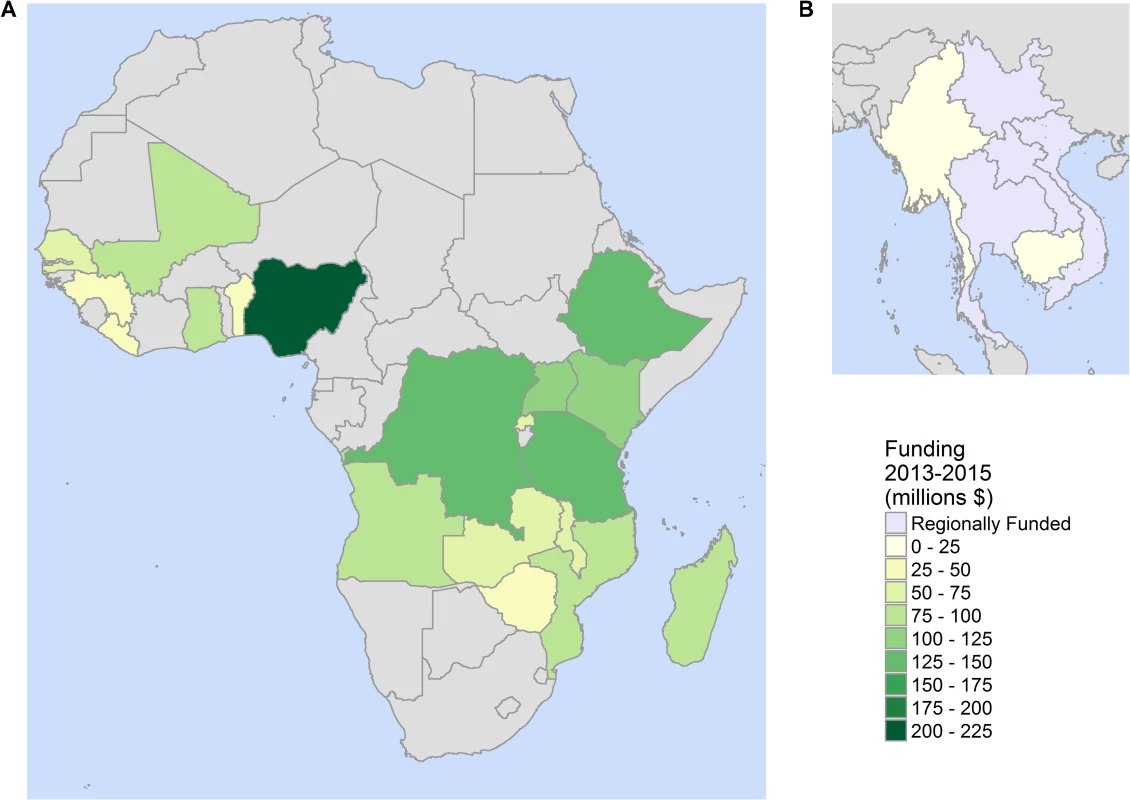
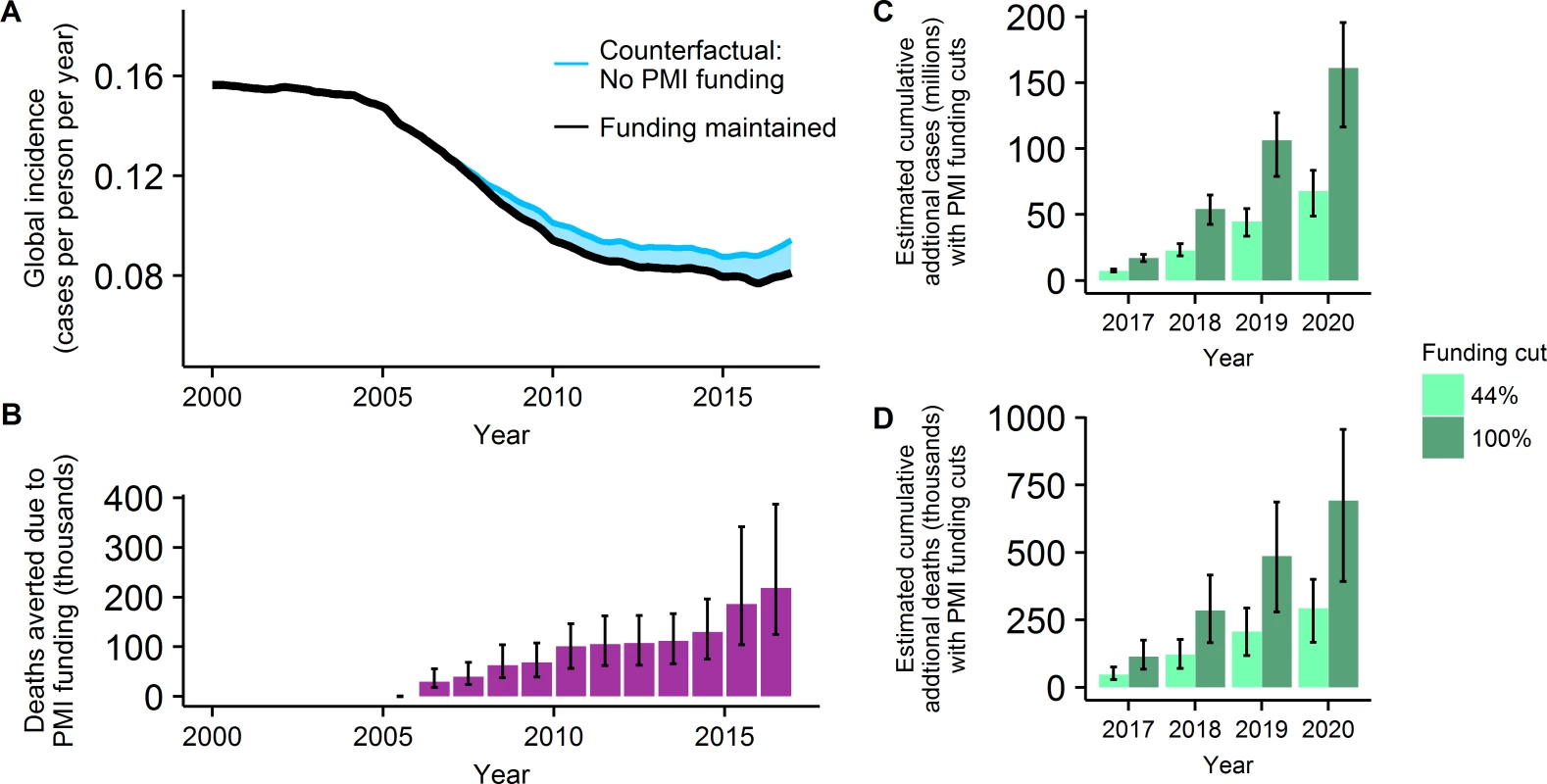
We estimate that a 44% cut in PMI funding would lead to an additional 67 million cases (95% CrI: 49 million, 82 million) (Fig 3B) and 290,649 deaths (95% CrI: 167,208, 395,263) (Fig 3C; S1 Appendix, Table F) from malaria compared to maintaining current levels of funding from 2017 to 2020. A 20% reduction in funding was associated with an additional 31 million cases (95% CrI: 21 million, 38 million) and 127,799 deaths (95% CrI: 73,313, 178,234) over the same period. If PMI-funded coverage of interventions can be maintained over the next 4 years, PMI support will be responsible for averting an estimated total of 162 million cases (95% CrI: 116 million, 194 million) (Fig 3B) and 692,589 deaths (95% CrI: 392,694, 955,653) (Fig 3C) in the 4-year period from 2017 to 2020, compared to no PMI support.
The impact on malaria burden will be focussed in high-burden countries receiving significant financial support in sub-Saharan Africa. Additionally, with ongoing concern surrounding the emergence and spread of ACT drug resistance [24], support for the GMS is also contributing to the malaria elimination goals in that region.
We estimate that PMI support would avert an additional US$174 million dollars (95% CrI: 121 million, 224 million) of national health system spending through averted malaria cases from 2017 to 2020 (Fig 4A). In the absence of PMI funding, a failure of health systems to absorb the extra caseload (through lack of capacity, finances, or both) would lead to an estimated 69,314 extra deaths (95% CrI: 39,102, 94,888) over this period (Fig 4B), in addition to the 692,589 deaths estimated to be directly caused by reductions in intervention coverage. These impact estimates are likely conservative, not accounting for the indirect impacts of increased transmission.
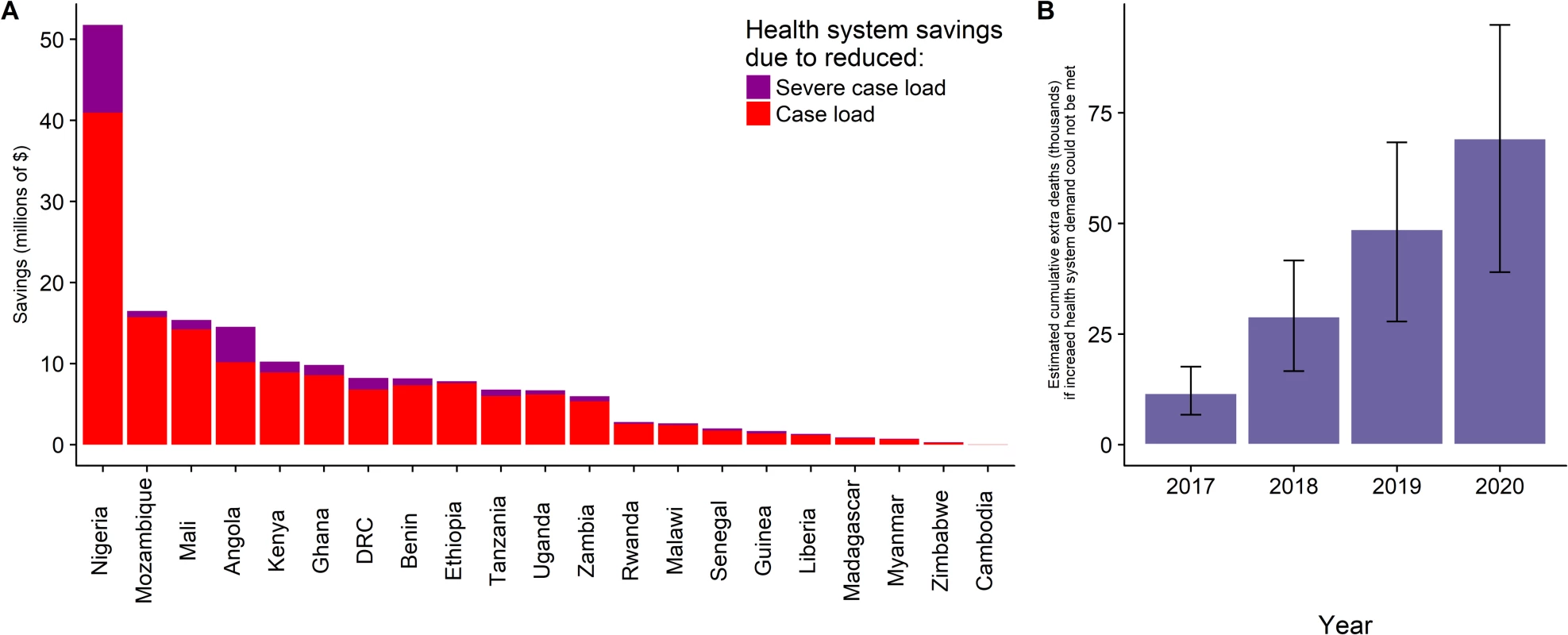
Over the period 2013–2015, when the PMI programme was fully scaled to current levels, PMI reported that spending in the 19 focus countries in sub-Saharan Africa was approximately US$1.7 billion. Translating the modelled epidemiological impact into system-wide cost-effectiveness, we estimate a cost of US$20.6 per malaria case averted (95% CrI: US$15.2, US$31.4), US$4,081 per death averted (95% CrI: US$2,084, US$7,435), and US$94 per DALY averted (95% CrI: US$51, US$166) (Table 1). This represents a range of 2%–57% as a proportion of per-capita gross domestic product (GDP) in these countries. Cost-effectiveness estimates are driven by the intervention mix and national-level differences in the cost of treating clinical and severe cases. Differences between cases and deaths averted are primarily driven by the intervention mix, especially the proportion of funding that went towards treatment (treatment contribution is positively associated with the proportion of deaths to cases averted, linear model coefficient = 0.012, p = 0.035).
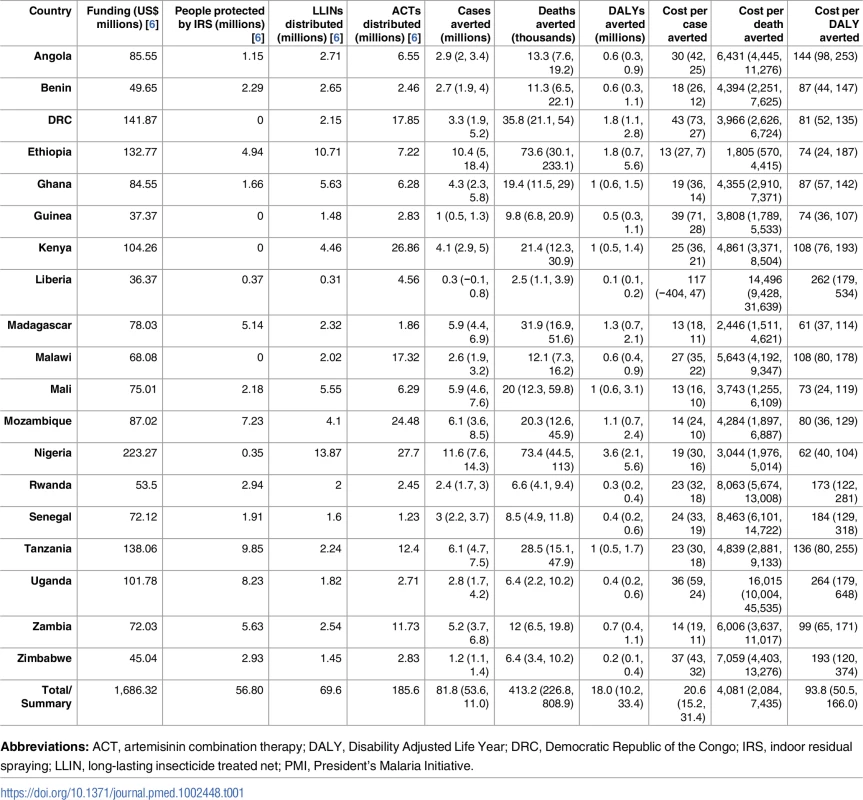
Discussion
Here, we have produced modelled estimates of the programme-wide effectiveness of PMI in terms of the impact it has had upon malaria morbidity and mortality since its inception in 2005. We estimate that PMI has averted 185 million cases and 940,049 deaths to date. If funding for PMI is maintained, we predict that a further 162 million cases and 692,589 deaths could be averted over the next 4 years, compared to no PMI funding. However, in comparison to continued full PMI support, a 44% cut in the PMI budget, as indicated in the May 2017 Congressional Budget Justification, could result in an additional 67 million cases and 290,649 deaths in the next 4 years.
Our results highlight the fragility of the gains in malaria control that have been made to date, particularly given the changing geopolitical landscape [25]. International funding, including that from governments, such as from PMI, the United Kingdom’s Department for International Development (DFID), the Global Fund, and others, accounts for a large proportion (approximately 68% [5]) of the funds available for malaria control worldwide. Malaria control is therefore reliant on sustained long-term investment from foreign donors. Without continued commitment to support programmes, recent gains in the control of malaria will be difficult to sustain and potential rebound epidemics likely [4].
Prudent investment of foreign aid relies on being able to effectively implement cost-effective interventions to maximise health gains. PMI has proven to be a capable mediator of this process for malaria. The estimates of cost per DALY averted here are significantly below the WHO threshold for cost-effectiveness of less than 300% of a country’s per-capita GDP [26]. Even among highly cost-effective interventions, malaria control compares favourably as a means by which to improve global health [27]. Between-country variation in cost-effectiveness is pronounced. The effect is driven by the intervention mix and underlying epidemiological variation (such as the intrinsic transmission potential). Costs are driven by the intervention mix and, specifically, the impact of PMI support on treatment costs, which varies between countries. Whilst the past and current positive health impacts of PMI-funded interventions is very apparent, there remains much debate as to the impact that foreign aid has on recipient countries [28].
In addition to its direct impact on cases and malaria-attributable mortality, investment in malaria control brings about substantial further potential health gains by alleviating the burden that malaria places on health systems in affected countries [29]. Supporting vector control interventions is expected to decrease caseloads, freeing up health system capacity and reducing costs incurred from treating clinical and severe cases of malaria. A recent PMI-supported study demonstrated reductions in malaria-related inpatient and outpatient admissions and hospital costs after the scale-up of interventions in Southern Province in Zambia [30]. Funding cuts lead to increased caseloads due to the negative impacts of reduced intervention coverage, the stress of which will be borne by the national health systems of malaria-endemic countries. Lack of health-system capacity was a critical factor in the recent Ebola epidemic in West Africa [31], the impact of which reverberated globally. Those countries worst affected are highly malaria endemic and had health systems already dealing with the challenges of a high malaria burden [32,33]. A redistribution of emergency funds earmarked for the Ebola epidemic [9] could potentially help to mitigate budget cuts for malaria control. However, this is a finite fund that would only serve as a very near-term solution to budget reductions.
Our results provide a conservative estimate of the overall impact of PMI funding, as we do not capture the impact of all PMI-associated activities, notably intermittent preventive treatment in pregnancy (IPTp), which we have not modelled but is one of the most cost-effective malaria interventions [34,35]. PMI presence in a country further catalyses and facilitates the procurement, distribution, and implementation of interventions from other funders with the initiative distributing 80 million LLINs and 34 million ACT courses procured by other donors in the period 2006–2015 [6]. Furthermore, PMI is involved with a number of capacity and health system-strengthening initiatives, such as training health workers in malaria diagnosis and treatment [6], the loss of which would compound issues of increased caseload if PMI support were reduced. Our estimates of reductions in under-5 mortality attributable to PMI funding are lower when compared with estimated reductions of a similar magnitude in all-cause mortality in a recently published difference-in-differences analysis of PMI impact [7]. Whilst our estimates of intervention coverage attributable to PMI funding are similar, the additional impact estimated by Jakubowski et al. may be ascribed to indirect impacts of PMI funding on nonmalaria outcomes (through, for example, health systems strengthening), although considerable uncertainties also impact both analyses. We also do not capture the wider societal costs of the disease, such as missed workdays by carers, reduced education, or impact on future lifetime earnings, nor the economic effects of endemic malaria on factors such as migration, trade, tourism, or foreign investment within a country [36]. It is likely that, when facing cuts, PMI and NMCPs would reallocate existing funds to cover those interventions seen as vital. However, in an already budget-restricted environment, a limit to the potentially mitigating effects of such reallocations would quickly be reached. There are a number of difficulties associated with estimating accurate coverage estimates and uptake for interventions with a wide range of definitions and methodologies adopted. We have assumed that PMI-reported contribution and interventions figures, taken from their 10th Annual Report to Congress [6] and building upon a well-established monitoring and evaluation strategy, are representative and accurate. We also are including assumptions that the PMI-delivered interventions are reaching required recipients in an efficient manner. Whilst we know inefficiencies do exist, for example in LLIN distribution [22], these are difficult to attribute to specific sources. Furthermore, due to the nonlinear impact of interventions such as LLINs, it is difficult to split contributions from different funding sources (i.e., should an X% funding contribution be linked to the first N% or last N% of observed LLIN coverage?). We do account for falloff between coverage and usage as well as deterioration of insecticide and wear and tear of LLINs in this analysis. Similarities to empirical estimates [8] indicate that we are accurately capturing broad trends in intervention coverage due to PMI funding.
As malaria transmission is brought to low levels, increased efforts are needed to target hard-to-reach populations as well as increase surveillance efforts, and hence the programmatic costs are likely to increase [7]. In such circumstances, investment decisions need to take into account the potential for permanent gains that would be accrued if an area or country can achieve elimination. However, there still remain large, extremely cost-effective gains that can be obtained by investing further to reduce the burden of malaria in areas of high endemicity. WHO GTS for malaria has set targets of achieving of at least 90% reductions in global case incidence and mortality rates by 2030 compared to levels in 2015, with vector control, chemoprevention, diagnosis and treatment, and surveillance being key pillars of the outlined strategy [37]. Based on the estimates of our model, PMI’s ongoing support of these activities in countries of high burden or strategic importance is vital in order to avoid a rapid erosion of the progress made in the last 15 years on the road towards malaria eradication.
Supporting Information
Zdroje
1. Bhatt S, Weiss DJ, Cameron E, Bisanzio D, Mappin B, Dalrymple U, et al. The effect of malaria control on Plasmodium falciparum in Africa between 2000 and 2015. Nature. 2015;8: 207–211. doi: 10.1038/nature15535 26375008
2. Alonso PL, Tanner M. Public health challenges and prospects for malaria control and elimination. Nat Med. 2013;19: 150–155. doi: 10.1038/nm.3077 23389615
3. Snow RW, Guerra CA, Mutheu JJ, Hay SI. International funding for malaria control in relation to populations at risk of stable Plasmodium falciparum transmission. PLoS Med. 2008;5: 1068–1078. doi: 10.1371/journal.pmed.0050142 18651785
4. Cohen JM, Smith DL, Cotter C, Ward A, Yamey G, Sabot OJ, et al. Malaria resurgence: a systematic review and assessment of its causes. Malar J. 2012;11: 122. doi: 10.1186/1475-2875-11-122 22531245
5. World Health Organization. World Malaria Report. Geneva; 2016.
6. USAID. The President’s Malaria Initiative: Tenth Annual Report to Congress. 2016.
7. Korenromp EL, Hosseini M, Newman RD, Cibulskis RE. Progress towards malaria control targets in relation to national malaria programme funding. Malar J. 2013;12: 18. doi: 10.1186/1475-2875-12-18 23317000
8. Jakubowski A, Stearns SC, Kruk ME, Angeles G, Thirumurthy H. The US President’s Malaria Initiative and under-5 child mortality in sub-Saharan Africa: A difference-in-differences analysis. PLoS Med. 2017;14: e1002319. doi: 10.1371/journal.pmed.1002319 28609442
9. Department of State. Congressional Budget Justification. 2017.
10. Foundation KF. Congress Releases FY17 Omnibus [Internet]. 2017 [cited 25 May 2017]. Available: http://kff.org/news-summary/congress-releases-fy17-omnibus/
11. Griffin JT, Bhatt S, Sinka ME, Gething PW, Lynch M, Patouillard E, et al. Potential for reduction of burden and local elimination of malaria by reducing Plasmodium falciparum malaria transmission: a mathematical modelling study. Lancet Infect Dis. Griffin et al. 2016;3099: 1–8. doi: 10.1016/S1473-3099(15)00423-5 26809816
12. Griffin JT, Ferguson NM, Ghani AC. Estimates of the changing age-burden of Plasmodium falciparum malaria disease in sub-Saharan Africa. Nat Commun. Nature Publishing Group; 2014;5: 3136. doi: 10.1038/ncomms4136 24518518
13. White MT, Griffin JT, Churcher TS, Ferguson NM, Basáñez MG, Ghani AC. Modelling the impact of vector control interventions on Anopheles gambiae population dynamics. Parasit Vectors. 2011;4: 153. doi: 10.1186/1756-3305-4-153 21798055
14. Griffin JT, Hollingsworth TD, Reyburn H, Drakeley CJ, Riley EM, Ghani AC. Gradual acquisition of immunity to severe malaria with increasing exposure. Proc Biol Sci. 2015;282. doi: 10.1098/rspb.2014.2657 25567652
15. Griffin JT, Hollingsworth TD, Okell LC, Churcher TS, White M, Hinsley W, et al. Reducing Plasmodium falciparum malaria transmission in Africa: a model-based evaluation of intervention strategies. Krishna S, editor. PLoS Med. Public Library of Science; 2010;7: e1000324. doi: 10.1371/journal.pmed.1000324 20711482
16. World Health Organization. World Malaria Report. Geneva; 2015.
17. Cohen JM, Woolsey AM, Sabot OJ, Gething PW, Tatem AJ, Moonen B. Public health. Optimizing investments in malaria treatment and diagnosis. Science. 2012;338: 612–614. doi: 10.1126/science.1229045 23118172
18. World Health Organization. World malaria report 2013. Geneva; 2013.
19. Garske T, Ferguson NM, Ghani AC. Estimating Air Temperature and Its Influence on Malaria Transmission across Africa. PLoS ONE. 2013;8. doi: 10.1371/journal.pone.0056487 23437143
20. Gething PW, Patil AP, Smith DL, Guerra C a., Elyazar IRF, Johnston GL, et al. A new world malaria map: Plasmodium falciparum endemicity in 2010. Malar J. 2011;10: 378. doi: 10.1186/1475-2875-10-378 22185615
21. CIESIN. Gridded Population of the World (GPW), v4 [Internet]. 2016. [cited 2017 Jan 12]: Available: http://beta.sedac.ciesin.columbia.edu/data/collection/gpw-v4
22. Bhatt S, Weiss D, Mappin B, Dalrymple U, Cameron E, Bisanzio D, et al. Coverage and system efficiencies of insecticide-treated nets in Africa from 2000 to 2017. Elife. 2015;4: e09672. doi: 10.7554/eLife.09672 26714109
23. PMI. PMI contributions to fight malaria [Internet]. 2017 [cited 25 May 2017]. Available: https://www.pmi.gov/about
24. Ashley EA, Dhorda M, Fairhurst RM, Amaratunga C, Lim P, Suon S, et al. Spread of Artemisinin Resistance in Plasmodium falciparum Malaria. N Engl J Med. 2014;371: 411–423. doi: 10.1056/NEJMoa1314981 25075834
25. Brech V, Potrafke N. Donor ideology and types of foreign aid. J Comp Econ. Association for Comparative Economic Studies; 2014;42: 61–75. doi: 10.1016/j.jce.2013.07.002
26. World Health Organization. Cost effectiveness and strategic planning (WHO-CHOICE) [Internet]. [cited 2017 Jun 6]: Available: http://www.who.int/choice/en/
27. Marseille E, Larson B, Kazi DS, Kahn JG, Rosen S. Thresholds for the cost-effectiveness of interventions: alternative approaches. Bull World Health Organ. 2015;93: 118–124. doi: 10.2471/BLT.14.138206 25883405
28. Lu C, Schneider MT, Gubbins P, Leach-Kemon K, Jamison D, Murray CJ. Public financing of health in developing countries: a cross-national systematic analysis. Lancet. Elsevier Ltd; 2010;375: 1375–1387. doi: 10.1016/S0140-6736(10)60233-4 20381856
29. Gething PW, Kirui VC, Alegana VA, Okiro EA, Noor AM, Snow RW. Estimating the number of paediatric fevers associated with malaria infection presenting to Africa’s public health sector in 2007. PLoS Med. 2010;7. doi: 10.1371/journal.pmed.1000301 20625548
30. Comfort AB, Van Dijk JH, Thuma PE, Mharakurwa S, Gabert R, Korde S, et al. Hospitalizations and costs incurred at the facility level after scale-up of malaria control: Pre-post comparisons from two hospitals in Zambia. Am J Trop Med Hyg. 2014;90: 20–32. doi: 10.4269/ajtmh.13-0019 24218409
31. Kieny MP, Evans DB, Schmets G, Kadandale S. Health-system resilience: reflections on the Ebola crisis in western Africa. Bull World Health Organ. 2014;92: 850. doi: 10.2471/BLT.14.149278 25552765
32. Plucinski MM, Guilavogui T, Sidikiba S, Diakit?? N, Diakit?? S, Dioubat?? M, et al. Effect of the Ebola-virus-disease epidemic on malaria case management in Guinea, 2014: A cross-sectional survey of health facilities. Lancet Infect Dis. 2015;15: 1017–1023. doi: 10.1016/S1473-3099(15)00061-4 26116183
33. Walker PGT, White MT, Griffin JT, Reynolds A, Ferguson NM, Ghani AC. Malaria morbidity and mortality in Ebola-affected countries caused by decreased health-care capacity, and the potential effect of mitigation strategies: a modelling analysis. Lancet Infect Dis. Elsevier; 2015; doi: 10.1016/S1473-3099(15)70124-6 25921597
34. White MT, Conteh L, Cibulskis R, Ghani AC. Costs and cost-effectiveness of malaria control interventions—a systematic review. Malar J. 2011;10: 337. doi: 10.1186/1475-2875-10-337 22050911
35. Walker PG, Floyd J, FO ter K, Cairns M. Estimated impact on birth weight of scaling up intermittent preventive treatment of malaria in pregnancy given sulphadoxine-pyrimethamine resistance in Africa: A mathematical model. PLoS Med. 2017;14: e1002243. doi: 10.1371/journal.pmed.1002243 28245259
36. Sachs JD, Malaney P. The economic and social burden of malaria. Nature. 2002;415: 680–685. doi: 10.1038/415680a 11832956
37. World Health Organization. Global technical strategy for malaria 2016–2030 [Internet]. Geneva, Switzerland; 2015 p. 29.
Štítky
Interní lékařstvíČlánek vyšel v časopise
PLOS Medicine
2017 Číslo 11
- Příznivý vliv Armolipidu Plus na hladinu cholesterolu a zánětlivé parametry u pacientů s chronickým subklinickým zánětem
- Berberin: přírodní hypolipidemikum se slibnými výsledky
- Léčba bolesti u seniorů
- Flexofytol® – přírodní revoluce v boji proti osteoartróze kloubů
- Nutraceutikum Armolipid Plus podle klinických důkazů zlepšuje lipidový profil − metaanalýza
Nejčtenější v tomto čísle
- Postmenopausal hormone therapy and risk of stroke: A pooled analysis of data from population-based cohort studies
- Bioequivalence between innovator and generic tacrolimus in liver and kidney transplant recipients: A randomized, crossover clinical trial
- HIV pre-exposure prophylaxis and early antiretroviral treatment among female sex workers in South Africa: Results from a prospective observational demonstration project
- Bioequivalence of twice-daily oral tacrolimus in transplant recipients: More evidence for consensus?
